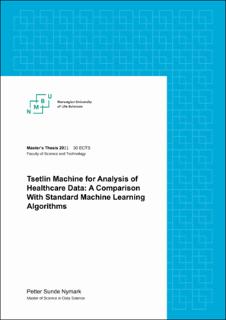| dc.description.abstract | In recent years, the use of machine learning within healthcare has increased as a result of a growing amount of data being produced. This data needs analyzing, and there exists many standard machine learning methods to do so. Many of these methods do however have problems when it comes to interpreting the models. Therefore, it is essential to find methods that provide good predictive performance and are interpretable in high-stake decision domains.
The Tsetlin Machine has shown up as a new and promising candidate regarding performance and interpretability. The Tsetlin Machine can be seen as a new branch within machine learning with propositional algebra-based logic to create models. The main aim of this thesis is to consider whether the Tsetlin Machine is applicable within the field of healthcare data science where the data considered as wide. It is also of interest to determine if the Tsetlin Machine can compete with standard algorithms to predict the survival of patients with colorectal cancer. Also, the interpretability of the Tsetlin Machine was explored, and the usefulness of this concept was evaluated.
This thesis used data from the OxyTarget study, a Norwegian study where MR images and blood sample markers were collected to analyze rectal cancer survival. There have also been other efforts, such as extracting radiomic features from the MRI. The analysis will try to predict a response variable called Progression Free Survival (PFS). The data used for predicting are radiomic features extracted from MRI images from the OxyTarget study. RENT was used to remove the features without information and thus increase predicative performance.
Dataset 1 combined version had F1-scores over 0.6 for all the models and had the highest MCCs. The best F1-score was 0.65 with SVM. The best MCC was from the Tsetlin Machine on the same version, achieving 0.33. Dataset 2 combined had the best overall score, with the Tsetlin Machine scoring 0.68 for F1-score and 0.42 for MCC. The Tsetlin Machine provided clauses in the form of propositional formulas.
The results indicate that the Tsetlin Machine can compete with the other models. For practical use in healthcare, the results are however not quite good enough. The Tsetlin Machine can also produce clauses for interpretability. These still need an automated process to display them in the original continuous values from the dataset. | en_US |

